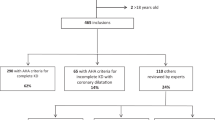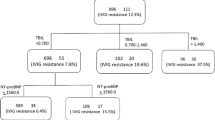Abstract
Since resistance to intravenous immunoglobulin (IVIG) is associated with coronary lesions (CALs) in Kawasaki disease (KD), it is crucial to identify patients at risk to protect them from coronary involvement. The available risk scores to predict IVIG resistance were developed in Asian populations in whom their effectiveness has been proven, but data on non-Asian children are limited. The aim of this study is to evaluate the ability of the Kobayashi, Egami, and Formosa risk scores to predict IVIG resistance and CALs in Italian patients with KD. A multicenter retrospective analysis involving children with KD diagnosed between 2000 and 2015 was carried out: 257 patients were enrolled (57.9% boys, 89.9% Caucasian); 43 patients were IVIG resistant (16.7%). The scores have low sensitivity and specificity in predicting IVIG resistance: respectively, KS 64% and 62.5%, ES 41.4% and 77.4%, and FS 70.8% and 44.9%. The predictive value of the 3 scores for predicting CALs was also poor.
Conclusion: Kobayashi, Egami, and Formosa Scores are ineffective in predicting IVIG resistance and coronary involvement in a predominantly Caucasian cohort. A specific score system for mostly Caucasian children with KD is needed enable the early identification of those at risk for CALs who could benefit from intensified treatment.
What is Known: • There are several risk scores developed in the Asian population to early identify patients with KD at risk for immunoglobulin-resistance and thus for coronary lesions. • Data are scarce on their effectiveness in non-Asian children. | |
What is New: • We present a comprehensive analysis of the ability of 3 Asian risk scores in a cohort of mostly Caucasian children to predict immunoglobulin resistance and coronary involvement. • Low sensitivity and specificity of the Asian scores for immunoglobulin-resistance and coronary lesions suggest the need for criteria specific for different ethnicities. |

Similar content being viewed by others
Abbreviations
- AHA:
-
American Heart Association
- ALT:
-
Alanine aminotransferase
- ASA:
-
Acetylsalicylic acid
- AST:
-
Aspartate aminotransferase
- CALs:
-
Coronary artery lesions
- CRP:
-
C-reactive protein
- ES:
-
Egami score
- ESR:
-
Erythrocyte sedimentation rate
- FS:
-
Formosa score
- Hb:
-
Hemoglobin
- IVIG:
-
Intravenous immunoglobulin
- KS:
-
Kobayashi score
- LDH:
-
Lactate dehydrogenase
- Na:
-
Sodium
- PLT:
-
Platelet count
- RBC:
-
Red blood cells
- SD:
-
Standard deviation
- WBC:
-
White blood cells
References
McCrindle BW, Rowley AH, Newburger JW, Burns JC, Bolger AF, Gewitz M, Baker AL, Jackson MA, Takahashi M, Shah PB, Kobayashi T, Wu MH, Saji TT, Pahl E, American Heart Association Rheumatic Fever, Endocarditis, and Kawasaki Disease Committee of the Council on Cardiovascular Disease in the Young; Council on Cardiovascular and Stroke Nursing; Council on Cardiovascular Surgery and Anesthesia; and Council on Epidemiology and Prevention (2017) Diagnosis, treatment, and long-term Management of Kawasaki Disease: a scientific statement for health professionals from the American Heart Association. Circulation 135:e927–e999. https://doi.org/10.1161/CIR.0000000000000484
Eleftheriou D, Levin M, Shingadia D, Tulloh R, Klein NJ, Brogan PA (2014) Management of Kawasaki disease. Arch Dis Child 99:74–83. https://doi.org/10.1136/archdischild-2012-302841
Bar-Meir M, Kalisky I, Schwartz A, Somekh E, Tasher D, Israeli Kawasaki Group (2018) Prediction of resistance to intravenous immunoglobulin in children with Kawasaki disease. J Pediatric Infect Dis Soc 7:25–29. https://doi.org/10.1093/jpids/piw075
Hwang JY, Lee KY, Rhim JW, Youn YS, Oh JH, Han JW, Lee JS, Burgner D (2011) Assessment of intravenous immunoglobulin non-responders in Kawasaki disease. Arch Dis Child 96:1088–1090. https://doi.org/10.1136/adc.2010.184101
Wei M, Huang M, Chen S, Huang G, Huang M, Qiu D, Guo Z, Jiang J, Zhou X, Yu Q, Guo Y, Fu L, Gao W, Li F (2015) A multicenter study of intravenous immunoglobulin non-response in Kawasaki disease. Pediatr Cardiol 36:1166–1172. https://doi.org/10.1007/s00246-015-1138-0
Singh S, Vignesh P, Burgner D (2015) The epidemiology of Kawasaki disease: a global update. Arch Dis Child 100:1084–1088. https://doi.org/10.1136/archdischild-2014-307536
Holman RC, Belay ED, Christensen KY, Folkema AM, Steiner CA, Schonberger LB (2016) Hospitalizations for Kawasaki syndrome among children in the United States, 1997–2007. Pediatr Infect Dis J 29:483–488. https://doi.org/10.1097/INF.0b013e3181cf8705
Onouchi Y, Ozaki K, Burns JC, Shimizu C, Terai M, Hamada H, Honda T, Suzuki H, Suenaga T, Takeuchi T et al (2012) A genome-wide association study identifies three new risk loci for Kawasaki disease. Nat Genet 44:517–521. https://doi.org/10.1038/ng.2220
Lee YC, Kuo HC, Chang JS, Chang LY, Huang LM, Chen MR, Liang CD, Chi H, Huang FY, Lee ML, Huang YC, Hwang B, Chiu NC, Hwang KP, Lee PC, Chang LC, Liu YM, Chen YJ, Chen CH, Alliance TPID, Chen YT, Tsai FJ, Wu JY (2012) Two new susceptibility loci for Kawasaki disease identified through genome-wide association analysis. Nat Genet 44:522–525. https://doi.org/10.1038/ng.2227
Chang CJ, Kuo HC, Chang JS, Lee JK, Tsai FJ, Khor CC, Chang LC, Chen SP, Ko TM, Liu YM, Chen YJ, Hong YM, Jang GY, Hibberd ML, Kuijpers T, Burgner D, Levin M, Burns JC, Davila S, International Kawasaki Disease Genetics Consortium¶, Korean Kawasaki Disease Genetics Consortium¶, Taiwan Kawasaki Disease Genetics Consortium¶, Chen YT, Chen CH, Wu JY, Lee YC (2013) Replication and meta-analysis of GWAS identified susceptibility loci in Kawasaki disease confirm the importance of B lymphoid tyrosine kinase (BLK) in disease susceptibility. PLoS One 8:e72037. https://doi.org/10.1371/journal.pone.0072037
Kobayashi T, Inoue Y, Takeuchi K, Okada Y, Tamura K, Tomomasa T, Kobayashi T, Morikawa A (2006) Prediction of intravenous immunoglobulin unresponsiveness in patients with Kawasaki disease. Circulation 113:2606–2612. https://doi.org/10.1161/CIRCULATIONAHA.105.592865
Egami K, Muta H, Ishii M, Suda K, Sugahara Y, Iemura M, Matuishi T (2006) Prediction of resistance to intravenous immunoglobulin treatment in patients with Kawasaki disease. J Pediatr 149:237–240. https://doi.org/10.1016/j.jpeds.2006.03.050
Sano T, Kurotobi S, Matsuzaki K, Yamamoto T, Maki I, Miki K, Kogaki S, Hara J (2007) Prediction of non-responsiveness to standard high-dose gamma-globulin therapy in patients with acute Kawasaki disease before starting initial treatment. Eur J Pediatr 166:131–137. https://doi.org/10.1007/s00431-006-0223-z
Lin MT, Chang CH, Sun LC, Liu HM, Chang HW, Chen CA, Chiu SN, Lu CW, Chang LY, Wang JK, Wu MH (2016) Risk factors and derived formosa score for intravenous immunoglobulin unresponsiveness in Taiwanese children with Kawasaki disease. J Formos Med Assoc 115:350–355. https://doi.org/10.1016/j.jfma.2015.03.012
Tremoulet AH, Best BM, Song S, Wang S, Corinaldesi E, Eichenfield JR, Martin DD, Newburger JW, Burns JC (2008) Resistance to intravenous immunoglobulin in children with Kawasaki disease. J Pediatr 153:117–121. https://doi.org/10.1016/j.jpeds.2007.12.021
Sleeper LA, Minich LL, McCrindle BM, Li JS, Mason W, Colan SD, Atz AM, Printz BF, Baker A, Vetter VL, Newburger JW, Pediatric Heart Network Investigators (2011) Evaluation of Kawasaki disease risk-scoring systems for intravenous immunoglobulin resistance. J Pediatr 158:831–835. https://doi.org/10.1016/j.jpeds.2010.10.031
Kobayashi T, Saji T, Otani T, Takeuchi K, Nakamura T, Arakawa H, Kato T, Hara T, Hamaoka K, Ogawa S, Miura M, Nomura Y, Fuse S, Ichida F, Seki M, Fukazawa R, Ogawa C, Furuno K, Tokunaga H, Takatsuki S, Hara S, Morikawa A (2012) Efficacy of immunoglobulin plus prednisolone for prevention of coronary artery abnormalities in severe Kawasaki disease (RAISE study): a randomised, open-label, blinded-endpoints trial. Lancet 379:1613–1620. https://doi.org/10.1016/S0140-6736(11)61930-2
Sánchez-Manubens J, Antón J, Bou R, Iglesias E, Calzada-Hernandez J, Borlan S, Gimenez-Roca C, Rivera J, Kawasaki Disease in Catalonia Working Group (2016) Role of the Egami score to predict immunoglobulin resistance in Kawasaki disease among a Western Mediterranean population. Rheumatol Int 36:905–910. https://doi.org/10.1007/s00296-016-3499-y
Loomba RS, Raskin A, Gudausky TM, Kirkpatrick E (2016) Role of the Egami score in predicting intravenous immunoglobulin resistance in Kawasaki disease among different ethnicities. Am J Ther 23:e1293–e1299. https://doi.org/10.1097/MJT.0000000000000045
Davies S, Sutton N, Blackstock S, Gormley S, Hoggart CJ, Levin M, Herberg JA (2015) Predicting IVIG resistance in UK Kawasaki disease. Arch Dis Child 100:366–368. https://doi.org/10.1136/archdischild-2014-307397
Newburger JW, Takahashi M, Gerber MA, Gewitz MH, Tani LY, Burns JC, Shulman ST, Bolger AF, Ferrieri P, Baltimore RS, Wilson WR, Baddour LM, Levison ME, Pallasch TJ, Falace DA, Taubert KA, Committee on Rheumatic Fever, Endocarditis and Kawasaki Disease, Council on Cardiovascular Disease in the Young, American Heart Association, American Academy of Pediatrics (2004) Diagnosis, treatment, and long-term management of Kawasaki disease: a statement for health professionals from the committee on rheumatic fever, endocarditis and Kawasaki disease, council on cardiovascular disease in the young, American Heart Association. Circulation 110:2747–2771. https://doi.org/10.1161/01.CIR.0000145143.19711.78
Ebato T, Ogata S, Ogihara Y, Fujimoto M, Kitagawa A, Takanashi M, Ishii M (2017) The clinical utility and safety of a new strategy for the treatment of refractory Kawasaki disease. J Pediatr 191:140–144. https://doi.org/10.1016/j.jpeds.2017.08.076
Jakob A, Horstmann J, Hufnagel M, Stiller B, Berner R, Schachinger E, Meyer K, Obermeier V (2018) Failure to predict high-risk Kawasaki disease patients in a population-based study cohort in Germany. Pediatr Infect Dis J:1. https://doi.org/10.1097/INF.0000000000001923
Chen S, Dong Y, Kiuchi MG, Wang J, Li R, Ling Z, Zhou T, Wang Z, Martinek M, Pürerfellner H, Liu S, Krucoff MW (2016) Coronary artery complication in Kawasaki disease and the importance of early intervention: a systematic review and meta-analysis. JAMA Pediatr 170:1156–1163. https://doi.org/10.1001/jamapediatrics.2016.2055
Author information
Authors and Affiliations
Contributions
Marianna Fabi conceptualized and designed the study and the data collection instruments, drafted the initial manuscript, and supervised the reviewed literature.
Laura Andreozzi carried out the statistical analysis and contributed to the collection of data, and to write the initial draft.
Elena Corinaldesi contributed to the collection of data and supervised the reviewed literature.
Tetyana Bodnar coordinated and supervised data collection, contributed to the critical revision of literature, and critically reviewed the manuscript.
Francesca Lami coordinated and supervised data collection, contributed to the critical revision of literature, and critically reviewed the manuscript.
Andrea Donti coordinated and supervised data collection, contributed to the critical revision of literature, and critically reviewed the manuscript.
Chiara Landini contributed to data acquisition and critically revised the manuscript.
Cristina Cicero contributed to data acquisition and critically revised the manuscript.
Monica Sprocati contributed to data acquisition and critically revised the manuscript.
Barbara Bigucci contributed to data acquisition and critically revised the manuscript.
Claudia Balsamo contributed to data acquisition and critically revised the manuscript.
Giorgia Di Fazzio contributed to data acquisition and critically revised the manuscript.
Federico Marchetti helped to draft the manuscript, contributed to the critical revision of literature, and reviewed the manuscript.
Bertrand Tchana helped to draft the manuscript, contributed to the critical revision of literature, and reviewed the manuscript.
Paola Sogno Valin helped to draft the manuscript, contributed to the critical revision of literature, and reviewed the manuscript.
Enrico Valletta helped to draft the manuscript, contributed to the critical revision of literature, and reviewed the manuscript.
Lorenzo Iughetti helped to draft the manuscript, contributed to the critical revision of literature, and reviewed the manuscript.
Marcello Lanari supervised the reviewed literature, contributed to the interpretation of data, and critically reviewed the manuscript for important content.
All authors approved the final manuscript as submitted and agreed to be accountable for all aspects of the work.
Corresponding author
Ethics declarations
Conflict of interest
The authors declare that they have no conflict of interest.
Ethical approval
The study was approved by the Central Review Board.
Informed consent
Informed consent was obtained from all individual participants included in the study.
Additional information
Communicated by Peter de Winter
Rights and permissions
About this article
Cite this article
Fabi, M., Andreozzi, L., Corinaldesi, E. et al. Inability of Asian risk scoring systems to predict intravenous immunoglobulin resistance and coronary lesions in Kawasaki disease in an Italian cohort. Eur J Pediatr 178, 315–322 (2019). https://doi.org/10.1007/s00431-018-3297-5
Received:
Revised:
Accepted:
Published:
Issue Date:
DOI: https://doi.org/10.1007/s00431-018-3297-5




